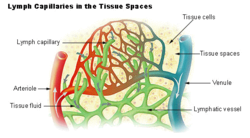Lymphatic
| Lymph | |
|---|---|

Diagram showing the formation of lymph from interstitial fluid (labeled here as "Tissue fluid"). Note how the tissue fluid is entering the blind ends of lymph capillaries (shown as deep green arrows)
|
|
| Details | |
| Identifiers | |
| Latin | Lympha |
| TA | A12.0.00.043 |
| FMA | 9671 |
|
Anatomical terminology
[]
|
|
Lymph is the fluid that circulates throughout the lymphatic system. The lymph is formed when the interstitial fluid (the fluid which lies in the interstices of all body tissues) is collected through lymph capillaries. It is then transported through larger lymphatic vessels to lymph nodes, where it is cleaned by lymphocytes, before emptying ultimately into the right or the left subclavian vein, where it mixes back with the blood.
Since the lymph is derived from the interstitial fluid, its composition continually changes as the blood and the surrounding cells continually exchange substances with the interstitial fluid. It is generally similar to blood plasma except that it doesn't contain red blood cells. Lymph returns proteins and excess interstitial fluid to the bloodstream. Lymph may pick up bacteria and bring them to lymph nodes, where they are destroyed. Metastatic cancer cells can also be transported via lymph. Lymph also transports fats from the digestive system (beginning in the lacteals) to the blood via chylomicrons.
The word lymph is derived from the name of the ancient Roman deity of fresh water, Lympha.
Lymph has a composition comparable to that of blood plasma, but it may differ slightly. Lymph contains white blood cells. In particular the lymph that leaves a lymph node is richer in lymphocytes. Likewise, the lymph formed in the human digestive system called chyle is rich in triglycerides (fat), and looks milky white.
...
Wikipedia
